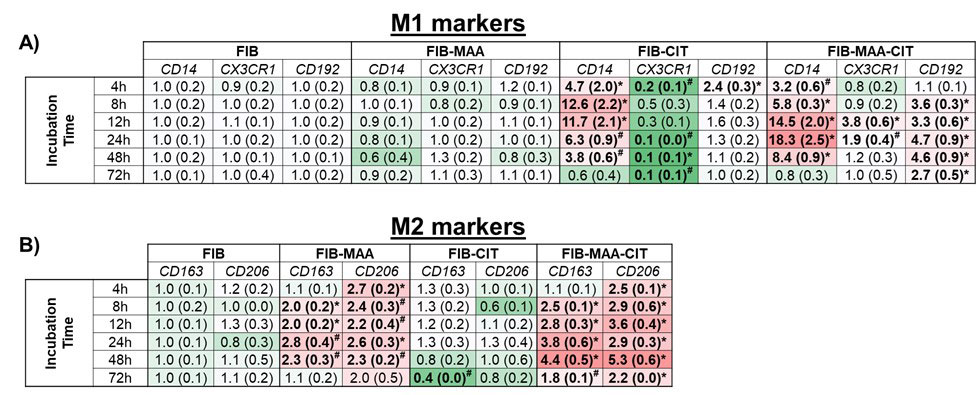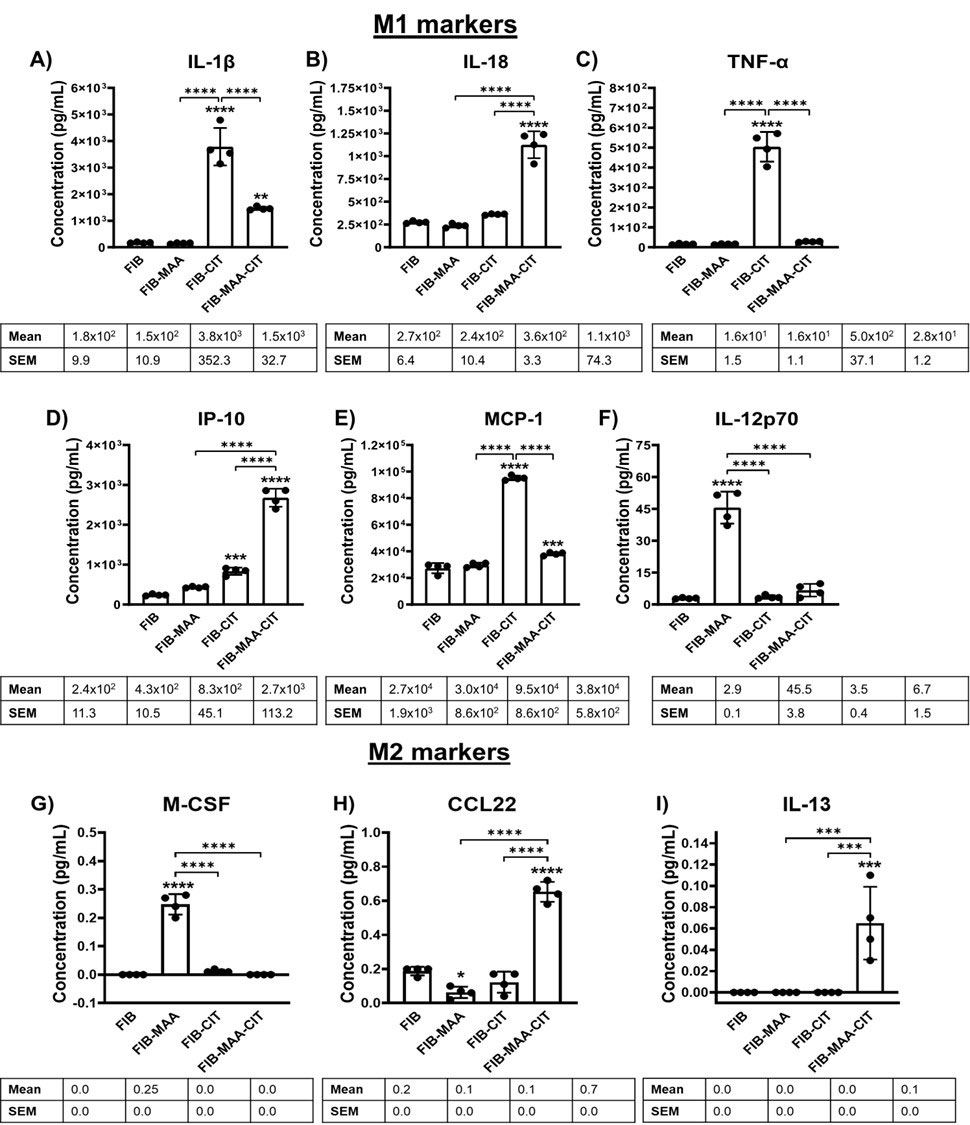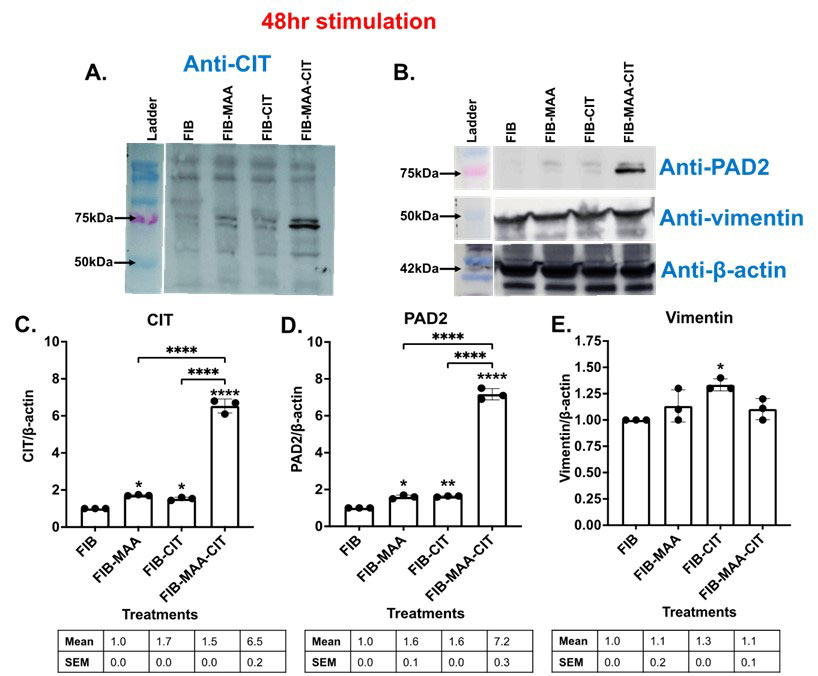Session Information
Session Type: Poster Session D
Session Time: 1:00PM-3:00PM
Background/Purpose: Post-translational modifications (PTM) of extracellular matrix proteins, such as fibrinogen, have been implicated in the pathogenesis of rheumatoid arthritis (RA). Citrullination, a type of PTM catalyzed by peptidylarginine deiminases (PAD), promotes inflammatory responses leading to the development of antibodies and T cell responses against citrullinated proteins, with anti-citrullinated protein antibody (ACPA) having up to 98% disease specificity in RA. Beyond citrullination, our laboratory has previously shown that proteins modified with malondialdehyde-acetaldehyde (MAA) acts as a potent antigens and targets of anti-MAA antibodies detected in RA patients. The purpose of this study was to determine whether fibrinogen (FIB) modified with citrulline (FIB-CIT), MAA (FIB-MAA) or both (FIB-MAA-CIT) leads to altered macrophage phenotype, PAD2 expression, and/or the production of citrullinated proteins.
Methods: Protein modifications were performed as described previously (Thiele et al. 2020). Phorbol 12-myristate 13-acetate (PMA)-treated U-937 cells (M0 cells) were stimulated with FIB-CIT, FIB-MAA, or FIB-MAA-CIT. Macrophage (M1/M2) phenotypes were evaluated by RT-PCR and ELISA. For RT-PCR, primers included both M1 markers: CD14, CD192, CX3CR1, and M2 markers: CD163, CD206. For ELISA, IL-1β, IL-18, TNF-α, IP-10, MCP-1, and IL-12p70 were measured as indicators of M1 polarization. M-CSF, CCL22, and IL-13 were measured as indicators of M2 polarization. Also, antigen stimulated M0 cells were evaluated for PAD enzyme expression and protein citrullination using Western Blot. Comparisons of assay data (RT-PCR, ELISA, Western Blot) from cells stimulated with native or modified FIB were performed using one-way ANOVA using Tukey’s post-hoc to account for multiple comparisons.
Results: M0 macrophages stimulated with FIB-MAA-CIT resulted in mixed M1/M2 phenotypes as demonstrated by mRNA levels of CD14, CD192, CD163, and CD206 (Fig.1, p< 0.001 vs. others), and the release of IL-1β, IL-18, MCP-1, IP-10, CCL22, and IL-13 (Fig.2, p< 0.001 vs. others). FIB-MAA treated M0 cells also demonstrated a mixed M1/M2 phenotype (IL-12p70 release, Fig.2; and M2 markers expression, Fig.1), but cytokine and cell surface markers differed from FIB-MAA-CIT. Finally, M0 cells treated with FIB-CIT demonstrated markers and cytokines consistent with only the M1-like phenotype. Exposure of M0 cells to FIB-MAA-CIT led to the highest increase of PAD2 protein expression (Fig.3, p< 0.001) and protein citrullination with the most predominant band at 75 kDa, aligning with the molecular weight for PAD2 (Fig.3, p< 0.001).
Conclusion: This study shows that a human monocyte cell line exposed to MAA-modified and/or citrullinated fibrinogen alters its phenotype and function in a modification-specific manner. This suggests a possible interconnection pathway(s) between post-translationally modified proteins, PAD enzyme expression, auto-citrullination, and immunoregulatory mechanism(s). Shifting the balance from a M1 pro-inflammatory response to a M2 pro-fibrotic response, and finally to a mixed M1/M2 response plays a central role in the generation of disease-specific autoimmunity.
To cite this abstract in AMA style:
Aripova n, Duryee M, hunter c, England B, Romberger D, O'Dell J, Thiele G, Mikuls T. Peptidyl Arginine Deiminase Expression and Macrophage Polarization Following Stimulation with Citrullinated and Malondialdehyde-acetaldehyde Modified Fibrinogen [abstract]. Arthritis Rheumatol. 2022; 74 (suppl 9). https://acrabstracts.org/abstract/peptidyl-arginine-deiminase-expression-and-macrophage-polarization-following-stimulation-with-citrullinated-and-malondialdehyde-acetaldehyde-modified-fibrinogen/. Accessed .« Back to ACR Convergence 2022
ACR Meeting Abstracts - https://acrabstracts.org/abstract/peptidyl-arginine-deiminase-expression-and-macrophage-polarization-following-stimulation-with-citrullinated-and-malondialdehyde-acetaldehyde-modified-fibrinogen/



